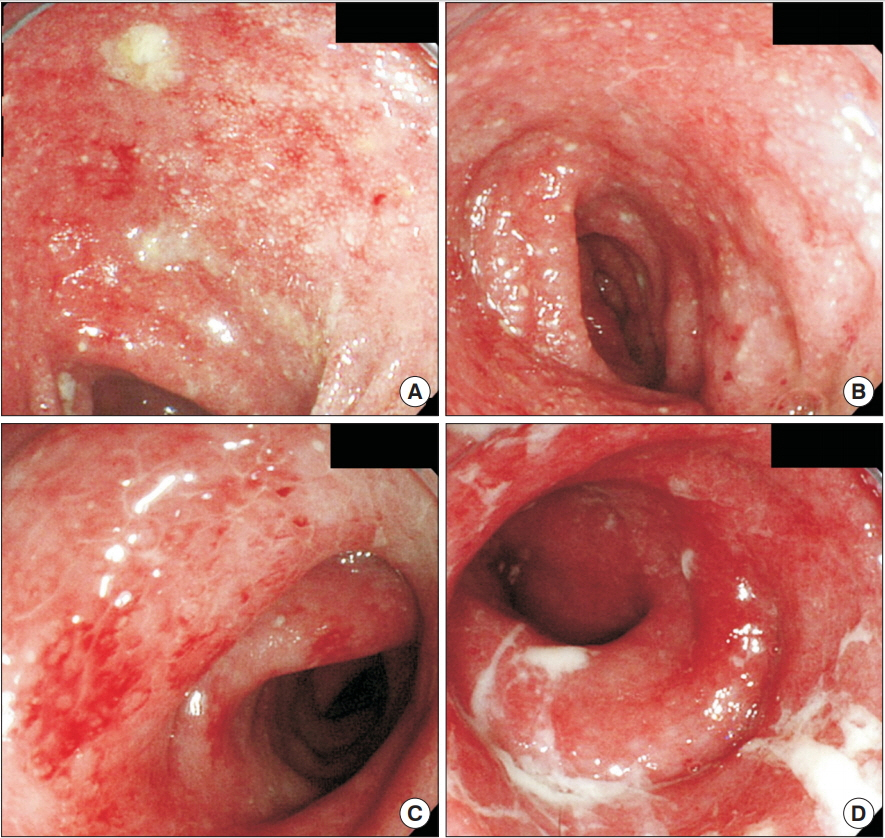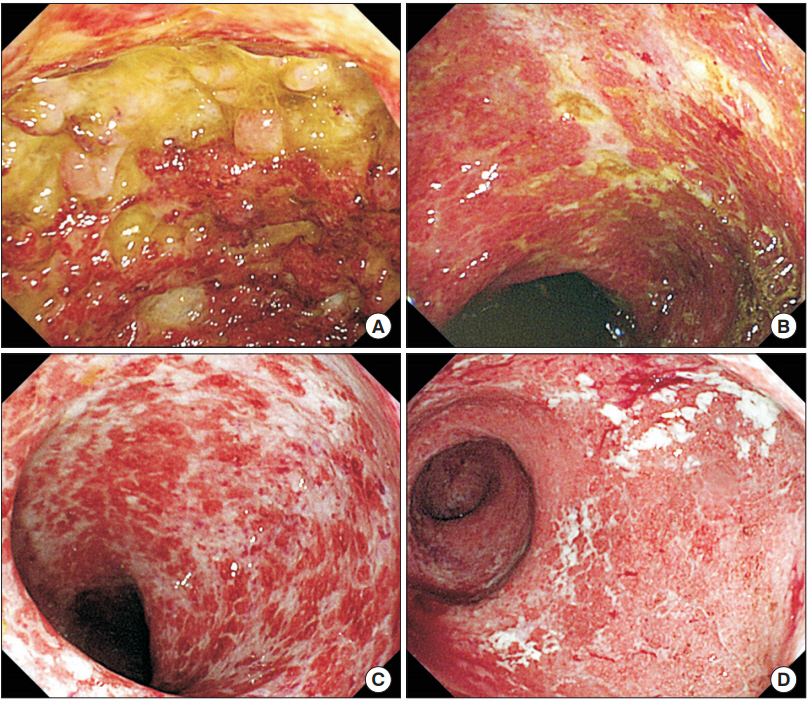Intest Res.
2018 Oct;16(4):635-640. 10.5217/ir.2018.00015.
5-Aminosalicylic acid aggravates colitis mimicking exacerbation of ulcerative colitis
- Affiliations
-
- 1Division of Gastroenterology and Hepatology, Department of Internal Medicine, Keio University School of Medicine, Tokyo, Japan. takagast@z2.keio.jp
- 2Center for Gastroenterology and Inflammatory Bowel Disease, Ofuna Chuo Hospital, Kamakura, Japan.
- 3Centers for Preventive Medicine, Keio University School of Medicine, Tokyo, Japan.
- 4Centers for Diagnostic and Therapeutic Endoscopy, Keio University School of Medicine, Tokyo, Japan.
- 5Center for Advanced IBD Research and Treatment, Kitasato University Kitasato Institute Hospital, Tokyo, Japan.
- KMID: 2434166
- DOI: http://doi.org/10.5217/ir.2018.00015
Abstract
- Ulcerative colitis (UC) is one of the major clinical phenotypes of inflammatory bowel diseases. Although 5-aminosalicylic acid (5-ASA) is widely used for UC and its efficacy and safety have been demonstrated, a few patients paradoxically develop a severe exacerbation of colitis by 5-ASA administration. It is crucial to know clinical features including endoscopic findings in this condition for making a correct diagnosis and a prompt decision to withdraw the medication. Here, we report case series with UC exacerbated by 5-ASA. Medical records of 8 UC patients experiencing an exacerbation of colitis after induction of 5-ASA that was improved by the withdrawal of 5-ASA but also re-aggravated by dose increase or re-administration of 5-ASA were reviewed. The patients were newly diagnosed with UC, started 5-ASA and developed an exacerbation in approximately 2 to 3 weeks. They did not appear to have systemic allergic reactions. Seven of the 8 patients had a high fever. Three of 5 patients who undertook total colonoscopy showed right-side-dominant colitis. These findings suggest clinical characteristics in this condition. Further assessment of clinical and endoscopic features in more cases is necessary for establishing diagnostic criteria and understanding underlying mechanisms in those cases where 5-ASA aggravates the colitis.
Keyword
MeSH Terms
Figure
Reference
-
1. Sninsky CA, Cort DH, Shanahan F, et al. Oral mesalamine (Asacol) for mildly to moderately active ulcerative colitis: a multicenter study. Ann Intern Med. 1991; 115:350–355.
Article2. Hanauer S, Schwartz J, Robinson M, et al. Mesalamine capsules for treatment of active ulcerative colitis: results of a controlled trial. Pentasa Study Group. Am J Gastroenterol. 1993; 88:1188–1197.3. Sandborn WJ, Kamm MA, Lichtenstein GR, Lyne A, Butler T, Joseph RE. MMX Multi Matrix System mesalazine for the induction of remission in patients with mild-to-moderate ulcerative colitis: a combined analysis of two randomized, double-blind, placebo-controlled trials. Aliment Pharmacol Ther. 2007; 26:205–215.
Article4. Chakraborty TK, Bhatia D, Heading RC, Ford MJ. Salicylate induced exacerbation of ulcerative colitis. Gut. 1987; 28:613–615.
Article5. Shanahan F, Targan S. Sulfasalazine and salicylate-induced exacerbation of ulcerative colitis. N Engl J Med. 1987; 317:455.
Article6. Kapur KC, Williams GT, Allison MC. Mesalazine induced exacerbation of ulcerative colitis. Gut. 1995; 37:838–839.
Article7. Sturgeon JB, Bhatia P, Hermens D, Miner PB Jr. Exacerbation of chronic ulcerative colitis with mesalamine. Gastroenterology. 1995; 108:1889–1893.
Article8. Iofel E, Chawla A, Daum F, Markowitz J. Mesalamine intolerance mimics symptoms of active inflammatory bowel disease. J Pediatr Gastroenterol Nutr. 2002; 34:73–76.
Article9. Gupta MK, Pollack S, Hutchings JJ. Mesalamine induced symptom exacerbation of ulcerative colitis: case report and brief discussion. World J Gastrointest Pharmacol Ther. 2010; 1:132–134.
Article10. Shimodate Y, Takanashi K, Waga E, Fujita T, Katsuki S, Nomura M. Exacerbation of bloody diarrhea as a side effect of mesalamine treatment of active ulcerative colitis. Case Rep Gastroenterol. 2011; 5:159–165.
Article11. Pichler WJ, Tilch J. The lymphocyte transformation test in the diagnosis of drug hypersensitivity. Allergy. 2004; 59:809–820.
Article12. Ford AC, Achkar JP, Khan KJ, et al. Efficacy of 5-aminosalicylates in ulcerative colitis: systematic review and meta-analysis. Am J Gastroenterol. 2011; 106:601–616.
Article13. Lim AG, Hine KR. Fever, vasculitic rash, arthritis, pericarditis, and pericardial effusion after mesalazine. BMJ. 1994; 308:113.
Article14. Daneshmend TK. Mesalazine-associated thrombocytopenia. Lancet. 1991; 337:1297–1298.
Article15. Nichols TW Jr. Experience with Eudragit-S coated mesalamine (Asacol) in inflammatory bowel disease: adverse events. J Clin Gastroenterol. 1994; 18:181.
Article16. Gisbert JP, González-Lama Y, Maté J. 5-Aminosalicylates and renal function in inflammatory bowel disease: a systematic review. Inflamm Bowel Dis. 2007; 13:629–638.17. Abdullah AM, Scott RB, Martin SR. Acute pancreatitis secondary to 5-aminosalicylic acid in a child with ulcerative colitis. J Pediatr Gastroenterol Nutr. 1993; 17:441–444.
Article18. Fernández J, Sala M, Panés J, Feu F, Navarro S, Terés J. Acute pancreatitis after long-term 5-aminosalicylic acid therapy. Am J Gastroenterol. 1997; 92:2302–2303.19. Kaiser GC, Milov DE, Erhart NA, Bailey DJ. Massive pericardial effusion in a child following the administration of mesalamine. J Pediatr Gastroenterol Nutr. 1997; 25:435–438.
Article20. Sviri S, Gafanovich I, Kramer MR, Tsvang E, Ben-Chetrit E. Mesalamine-induced hypersensitivity pneumonitis: a case report and review of the literature. J Clin Gastroenterol. 1997; 24:34–36.
- Full Text Links
- Actions
-
Cited
- CITED
-
- Close
- Share
- Similar articles
-
- 5-aminosalicylic acid in the management of ulcerative colitis
- 5-Aminosalicylic Acid-induced Myocarditis in a Patient with Atypical Ulcerative Colitis
- A Case of Acute Pancreatitis Caused by 5-aminosalicylic Acid Suppositories in a Patient with Ulcerative Colitis
- Advances in ulcerative colitis therapy
- Golimumab Therapy in Ulcerative Colitis



